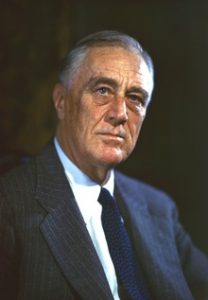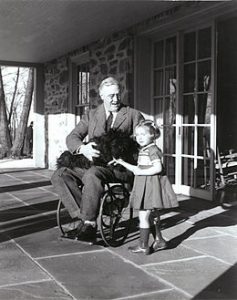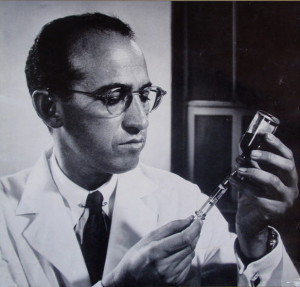Dr Rod Amos, a retired consultant rheumatologist at the Royal Hallamshire and Sheffield Children’s Hospital who last spoke to us in January 2014 on Changing Concepts of Medicine (from Sorcery to Science), returned with a fascinating account of the almost total eradication of poliomyelitis.
Specifically, his talk centred on the involvement in fundraising of Franklin D Roosevelt, the 32nd President of the United States, who was himself struck down with a paralytic illness (there is some debate as to whether it was actually polio) in 1921, at the age of 39.
Roosevelt, who would subsequently be elected to the first of his record four terms as president in November 1932, was the only child of a rich and political family, and was at his holiday home at Campobello Island, a popular summer retreat for wealthy Canadians and Americans, when he was taken ill with exhaustion, deep muscle aching and feverishness. Within a day he was showing signs of paralysis which eventually left him unable to walk or even stand without some kind of support.

He was crippled, as Rod pointed out, at a time when such a disability was a major problem to someone who wanted to be prominent in public life. He laboriously taught himself to walk very short distances while wearing cumbersome iron braces on his hips and legs by swivelling his torso and supporting himself with a cane, and he was careful never to be seen using his wheelchair in public.
Although his illness was generally known, the extent of his paralysis was kept from public view, helpedby a gentlemen’s agreement with the Press that there would be no photographs or caricatures revealing his disability, and he would often stand for two or three hours while making speeches at public meetings, his leg irons and hip brace locked in position but concealed by a specially constructed three-sided podium.

Roosevelt tried a wide range of remedies, and particularly favoured hydrotherapy. He believed that swimming in the warm, buoyant mineral water of the Warms Springs resort in Georgia was beneficial. “Franklin Roosevelt will swim to health,” proclaimed one newspaper headline of the day. He became obsessed with it, to the extent that in 1926 he bought Warm Springs and turned it from a resort to an institute for polio rehabilitation, setting up a non-profit organisation able to benefit from tax-free gifts and charitable donations.
The Georgia Warm Springs Foundation was renamed the National Foundation for Infantile Paralysis in 1927 and Keith Morgan, a successful insurance salesman, was brought in to sell the idea to prospective wealthy patrons, a business plan which fell victim to the Wall Street crash of 1929. Carl Byoir, a PR expert, was hired to raise the foundation’s profile and suggested a nationwide party to celebrate FDR’s birthday in 1934, organising 3,000 ‘birthday balls’ around the country. This became an annual event from which 70 per cent of the profits were retained by local communities to provide care for polio victims and 30 per cent went to the foundation.
The name March of Dimes – a play on the title of a contemporary American radio and newsreel series, The March of Time – was coined by Eddie Cantor, who was a radio show host as well as a popular singer, comedian and screen star. The foundation had decided at Byoir’s suggestion on a nationwide fundraising campaign which would encourage large numbers of small donations rather than a few large bequests, and Cantor inspired a fundraising campaign in the week before President Roosevelt’s birthday on January 30, 1938.
Lapel pins were sold at ten cents (a dime) each, and thousands of people mailed cards and letters, each containing a dime, to the White House. On the first day 30,000 dimes were received, on the second day 50,000 and on the third day 150,000. Along with the proceeds from special events held by nightclubs and cabarets, and special features produced by motion picture studios and the radio industry, Cantor’s appeal raised more than $85,000 in what the Press called ‘a silver tide which actually swamped the White House.’ Over the years, half a billion dollars would be raised in the fight against polio.
The word poliomyelitis comes from the Greek words polios, meaning grey, and meulos or myelós, meaning marrow or spinal cord. It would often cause respiratory paralysis and Rod, who was born in 1948, struck a note with many in the audience when he said: “In my early childhood, when polio was mentioned, the image which came into my mind was the iron lung.”

The big breakthrough in the eradication of polio came in the period 1951 to 1953 when Dr Jonas Salk, a medical researcher and virologist, was given more than $1 million in funding by the National Foundation for Infantile Paralysis in his quest to find a cure, and the Salk Vaccine was introduced in 1955. Salk’s ‘killed’ vaccine was effective in eliminating most of the complications of polio, but did not prevent the initial intestinal infection.
But in late 1954, Salk’s rival Dr Albert Sabin had tested his ‘live’ attenuated oral vaccine, and between 1955 and 1961 the oral version was trialled on at least 100 million people in the USSR and other countries. This provided the impetus for large-scale clinical trials of the oral vaccine in the US, in the face of considerable opposition from the National Foundation for Infantile Paralysis.

“Salk and Sabin hated each other,” Rod revealed. “There was a lot of rivalry. Many scientists had long thought that a live, oral version made more logical sense, but the National Foundation wouldn’t support the cost of another massive vaccination project before the Salk vaccine was up and running,”
However, from 1962 onwards the USA and much of the world switched to the Sabin version.
